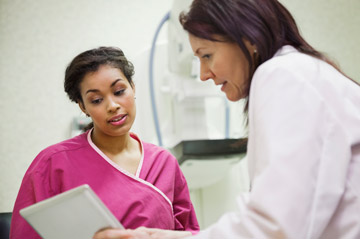Let's Talk Mammograms

A mammogram is a screening that helps to detect abnormalities in the breast – namely breast cancer. And there are natural fears that come up when we hear the word ‘cancer’. But what if we looked at mammograms a little differently – as a tool that helps us to rule out breast cancer? In fact, in most cases, that's exactly what it does.
According to the American College of Radiology, “For every 1,000 women who have a screening mammogram, five are diagnosed with breast cancer.” That's less than 1%. And if an abnormality does exist, a mammogram can detect it at an early stage, dramatically increasing the chance of a full recovery.
At Memorial Hermann, we are passionate about proactive care. Every day, women trust our experienced mammography technicians to provide the most advanced screenings in a friendly, comfortable environment. And the positive feedback we receive from patients means the world to us.
We'll talk more about what to expect at a screening, but first, let's discuss recommended guidelines, so you know when, and how often you need to schedule your mammogram.
Where to Go to Get a Mammogram. You Have a Choice.
Having a mammogram could be one of the most important health care decisions you’ll every make, and it doesn’t have to be a negative experience. You have a choice of where to go.
Unlike freestanding mammography centers, Memorial Hermann Imaging and Breast Care Centers offer a full range of breast health services in an environment focused on your peace and comfort.
Less Anxiety. More Comfort.
Memorial Hermann Breast Care Centers are committed to easing your anxiety and increasing your comfort level. In a calm and caring environment, we provide emotional support and luxury amenities, including:
- Private changing rooms
- Warmed robes
- Blanket-like coverlets on top of the imaging plates
- Supportive staff attentive to your needs
- Clear answers and step-by-step guidance from board-certified radiologists
What are the Different Types of Mammograms?
The type of mammogram you receive depends on a variety of factors, including medical and family history, age and even preference.
The three main types include:
Screening Mammogram
If you show no preexisting signs of breast cancer, including a lump in the breast, nipple discharge or breast skin changes, a screening mammogram will most likely be recommended (in accordance with American Cancer Society guidelines).
A screening mammogram is a routine, non-invasive X-ray of the breast (mammary glands) which looks for potential breast problems, such as a lump or other abnormality and usually consists of two standard images of each breast.
Memorial Hermann offers the SmartCurve system for 3-D screening mammograms at some locations. This technology provides a curved compression surface for a more comfortable patient experience. Your mammography technologist will confirm if you are a candidate for SmartCurve during your screening appointment.
Research shows that many small tumors can be seen on a mammogram before they can be felt by a woman or her health care professional. This is why mammograms are so important. Detection of an abnormality at this early stage can mean treatments that are less invasive and more effective. If your screening mammogram does show an abnormality, you may need additional imaging.
Diagnostic Mammogram
A diagnostic mammogram is used to evaluate abnormalities that have already been detected, either through a breast self-exam at home or a screening mammogram. These X-rays usually consist of three standard images of each breast plus more focused images of the area(s) of concern.
This advanced mammogram provides radiologists with an in-depth picture of problems, changes or concerning symptoms, allowing them to better assess the next course of action.
3D Mammograms (Tomosynthesis)
We don’t yet have a cure for breast cancer, but we are living in extraordinary times with exceptional technologies. One of the latest advancements is digital breast tomosynthesis.
Traditional mammograms, referred to as 2D or two-dimensional, usually consist of two standard images. Digital breast tomosynthesis, more commonly referred to as a 3D mammogram, is an innovative, FDA-approved digital technology that helps doctors detect smaller tumors, sooner.
The benefits:
- Visibility: This breakthrough technology allows your radiologist to look through layers of normal breast tissue and detect small findings that may not be visible on a traditional 2D mammogram.
- Accuracy: Images are sharper and faster, contributing to improved accuracy in screening results and detection of breast cancer in the earliest stages.
- Flexibility: Your doctor can enhance, magnify or optimize images for closer evaluation or interpretation—providing increased contrast and a better view through the dense tissue typical of younger women.

Mammogram Reminder
Early detection is the best defense against breast cancer, which is why Memorial Hermann can send you a reminder to schedule your annual screening mammogram.
Remind MeI'm Ready to Make an Appointment. Is There Anything I Need to Do to Prepare?
First, congratulate yourself. You’re taking an important and proactive step to protect your health. And if you’re choosing to have your screening at a Memorial Hermann Imaging and Breast Care Center, you’re already off to a great start.
When you schedule your appointment, you’ll receive some information to help prepare for your screening. But below are a couple of tips to get you started:
- On the day of your mammogram, we recommend that you don’t use deodorant, perfume, powders or ointments. The residue left on your skin by these substances may interfere with the X-rays.
- If you’re still having menstrual periods, consider booking your mammogram within the two weeks after your menstrual period ends, when your breasts are less tender.
Comparison with prior imaging is key to assessing for change and accurate diagnosis. Please bring a CD of your prior studies if your prior breast health studies were performed outside of Memorial Hermann. If you need us to request your prior films from another facility, please complete a medical release of information from and return it to our facility prior to your appointment. Once received, we will request the films.
What Should I Expect When I Arrive for My Screening?
When you arrive, one of our specialists will greet you in the waiting area with a warm, soft robe. You’ll be asked to remove any jewelry that might interfere with the X-ray picture, remove your clothes above the waist and put on your robe.
When it's time for your screening, a technician will lead you to a private room and explain the steps she will take. At this time, and throughout the process, we encourage you to ask any questions you might have about the screening.
If you’re receiving a diagnostic mammogram, be sure to show the technologist any areas of your breast that you might be concerned about.
What Happens During the Screening?
For most patients, a mammogram screening is much easier than expected, but if at anytime you feel too uncomfortable, let us know. We are here to help.
What to expect during your mammogram:
Your mammography technician will escort you to your private mammography room. She will ask you some questions about your health history and prepare you for the procedure.
- During the screening, your breasts will be positioned on a flat plate, one at a time. Another plate will come down and compress your breast tissue. Firm compression is needed to obtain high-quality pictures, but the process is quick and will be over before you know it. For the few seconds while the X-ray picture is taken, you’ll be asked to hold your breath.
- At least two pictures will be taken of each breast, one from the top and one from the side.
- The X-ray plate will feel cold when you place your breast on it. Having your breasts flattened and squeezed can be a bit uncomfortable. But keep in mind that it is necessary to flatten out the breast tissue to obtain the best images. The mammogram itself will only take about 10 to 15 minutes, but you should plan to be in the mammogram clinic for about an hour.
- After the test, a radiologist will interpret your exam and send a report to your doctor's office. You will receive a letter with your mammogram results within 5 - 7 business days of your exam date.
Are There Limitations to Mammography?
Mammograms are an important tool to rule out, or detect breast cancer, but there are limitations - mainly based on factors like age and breast density. These limitations, however, are diminishing as the technology consistently improves.
Before you schedule your mammogram, remember to consult with your doctor about personal risk factors, when you should start getting mammograms and if an annual schedule is best for you.
Breast Care Guidelines are updated regularly, so it's best to keep yourself informed with the latest news and recommendations. If you have any questions, we're happy to help.
Stay On Top of Your Breast Health In Between Mammograms.
The Memorial Hermann team recommends women begin screening for breast cancer at age 40 in accordance with The American College of Surgeons (ACS) guidelines. Also, in between mammograms, it is important to examine your breasts at home regularly to detect any abnormalities.
"Know your body. That's the No. 1 piece of advice I have to offer,” says Oncology Nurse Navigator, Carol Kirton, BSN, RN, OCN. “When you know your own body—and especially your breasts -even minor changes are more noticeable and should be brought to the attention of your physician."
In addition to the tips below, please download and print our free guide that explains how to perform a breast self-exam.
When performing a breast exam at home, check for:
- A new lump in your breast
- Enlarged lymph nodes in the armpit
- Changes in your breast size
- Changes in the shape of your breast
- Changes in skin texture or color
- Skin redness
- Dimpling or puckering
- Scaliness
- Your nipple pulling to one side
- A change in the direction of your nipple
- New bloody or clear nipple discharge from only one breast
Make an Appointment
Schedule a routine screening mammogram online 24/7 using ScheduleNow. You can also schedule by phone by calling (877) 40.MAMMO (62666).
Contact Us
Complete the form below to be connected to our Nurse Navigator – a dedicated registered nurse who specializes in breast health and is available to provide education and resources.
Screening Mammogram
A screening mammogram is an X-ray test of the breast used to screen for breast problems when there have been no concerning symptoms detected.
Diagnostic Mammogram
A diagnostic mammogram is used to evaluate abnormalities that have already been detected through a self-exam or a screening mammogram.
3D Mammogram (Tomosynthesis)
Digital breast tomosynthesis, more commonly referred to as a 3D mammogram, is an innovative, FDA-approved technology that helps detect smaller tumors sooner.